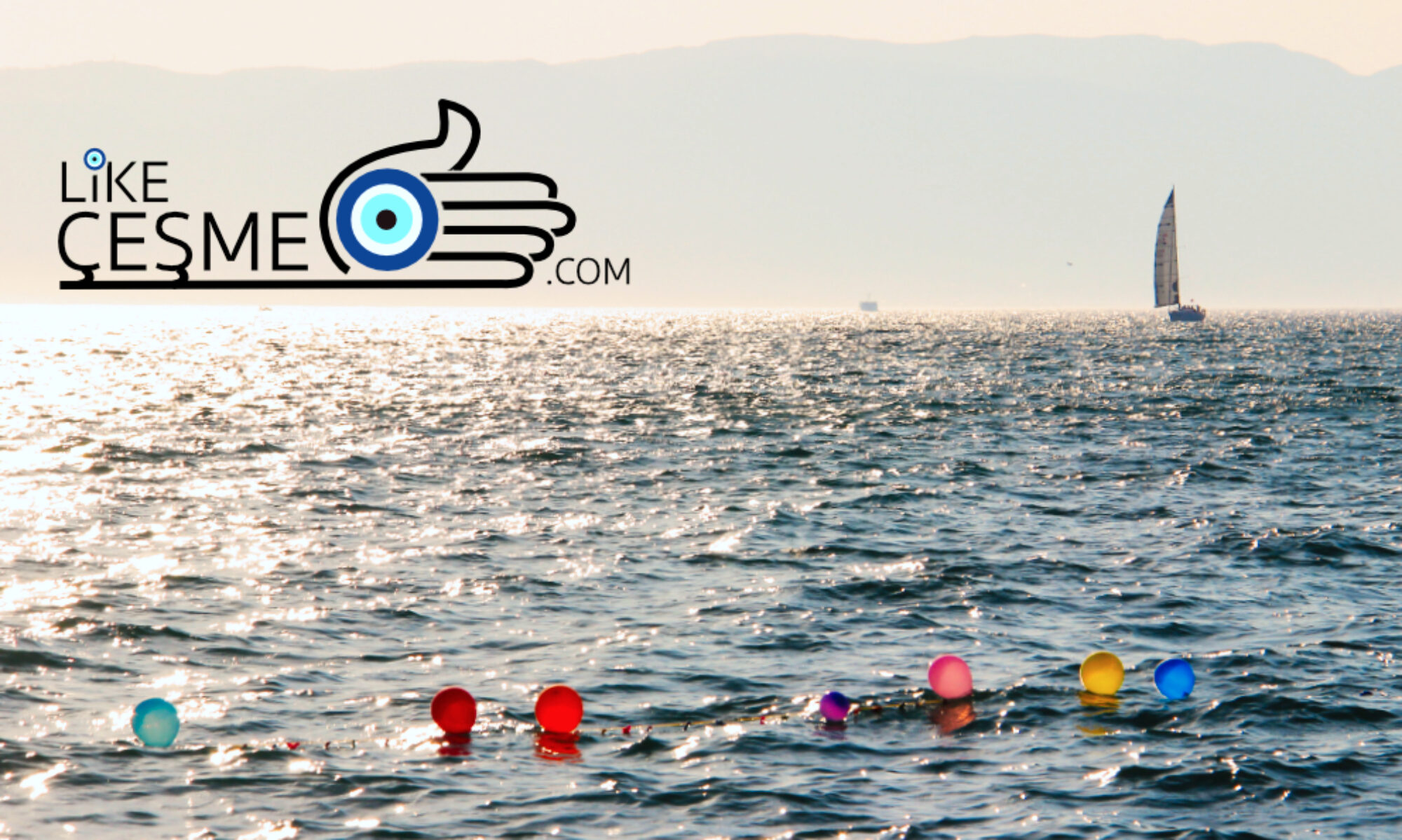İzmir is a popular tourist destination known for its rich history, vibrant culture, and beautiful coastal scenery. Key Izmir attractions include Konak Square, the city’s heart, featuring the iconic İzmir Clock Tower and the historic Konak Mosque. Kemeralti Bazaar: A bustling market area with shops, cafes, and historical sites. Kadifekale: An ancient fortress offering panoramic views of the city and the gulf. Agora of Smyrna: Ruins of an ancient Roman marketplace, providing a glimpse into the city’s past. Kordon: A scenic promenade along the waterfront, perfect for leisurely walks and enjoying the sunset.
See also Izmir Archaeological Sites and Izmir Museums.
Izmir Attractions – Table of Contents
Konak Meydanı – Clock Tower
Location: İzmir Saat Kulesi – Konak, 35360 Konak/İzmir
The İzmir Clock Tower (İzmir Saat Kulesi) is one of the most recognisable landmarks in İzmir and symbolises the city’s rich history and modernisation. Located in Konak Square, the city’s heart, the tower has become a central meeting point and an iconic part of İzmir’s cultural heritage. The Clock Tower was built in 1901 to commemorate the 25th anniversary of Sultan Abdulhamid II’s (1842-1918) ascension to the throne. The tower’s construction was a broader trend during the late Ottoman period to modernise cities with new public works and infrastructure projects. The tower was designed by the Levantine French architect Raymond Charles Père (1854-1929), and its clock was a gift from Kaiser Wilhelm II (1859-1941) of Germany, symbolising the friendly relations between the Ottoman Empire and Germany during the time. It has witnessed significant historical events, including the Great Fire of Smyrna in 1922 and the subsequent rebuilding of the city.
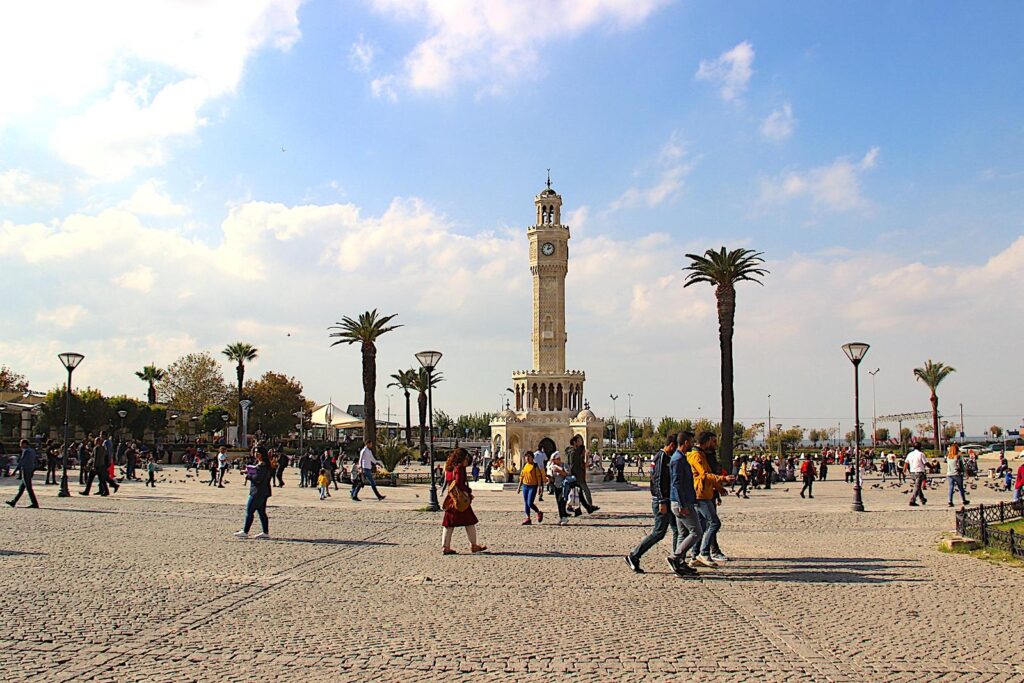
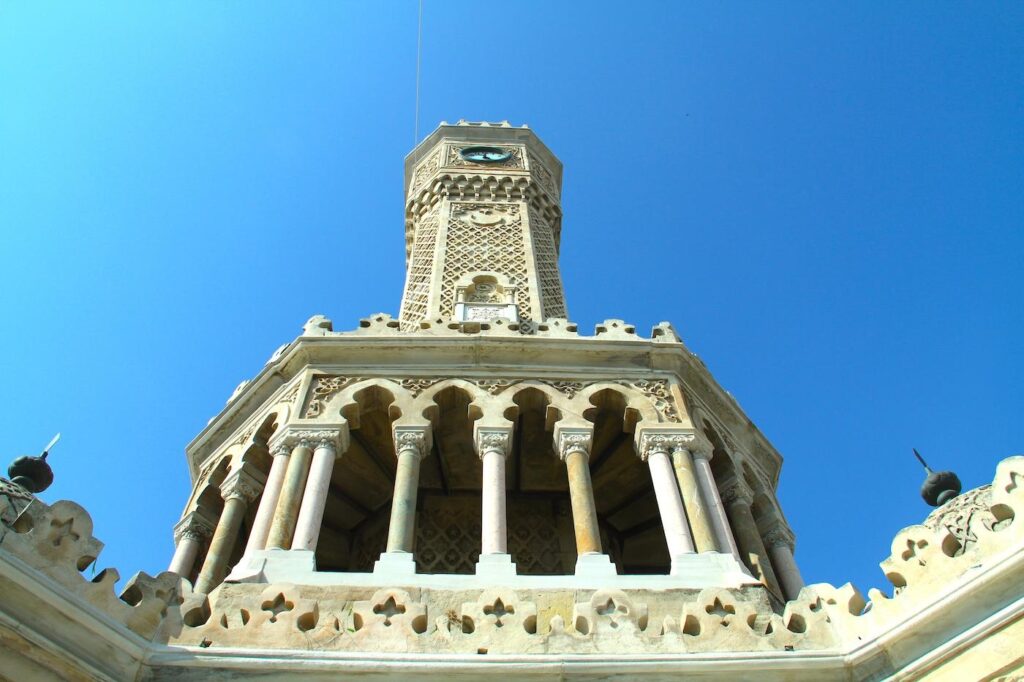

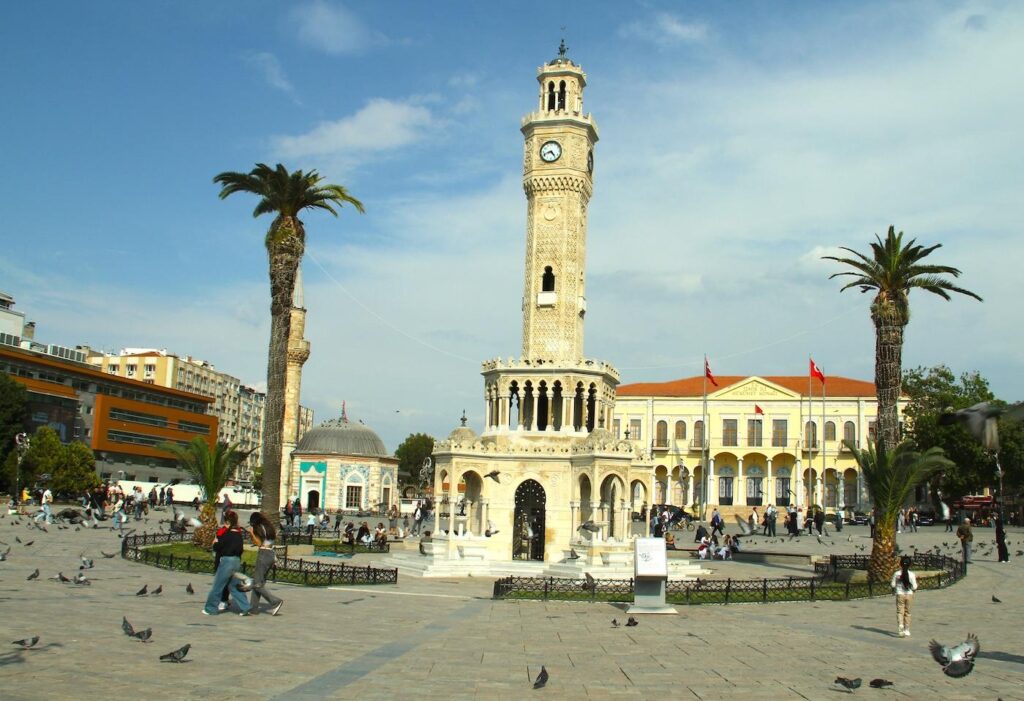
The İzmir Clock Tower is 25 metres tall and is an example of Ottoman architecture. Its intricate details and elegant design reflect both local and international influences. The base of the tower is octagonal and made of white marble, providing a solid foundation. It features four fountains (şadırvan), each with an elaborately decorated basin at the base’s corners. These fountains highlight the Islamic architectural tradition of incorporating water elements into public structures. The tower’s body is supported by slender, fluted columns that rise from the base to the first level. Each side of the octagonal structure features arched openings, adding to the aesthetic appeal and providing lightness and openness. The clock itself is housed in a cylindrical section above the arches. It has four clock faces, one on each side, allowing it to be viewed from all directions in Konak Square. A German company crafted the clock mechanism, which has been meticulously maintained over the years to ensure accuracy.
Konak Meydanı – Government House
The Government House (Hükümet Konağı) at Konak Square was constructed during the Ottoman period, around the mid-19th century, to serve as the administrative centre of the region. It was designed to accommodate various governmental functions, including offices for the governor and other officials. Like much of İzmir, the Great Fire of Smyrna in 1922 heavily impacted the building. After establishing the Turkish Republic in 1923, the Government House continued to function as the central administrative building for the İzmir province.
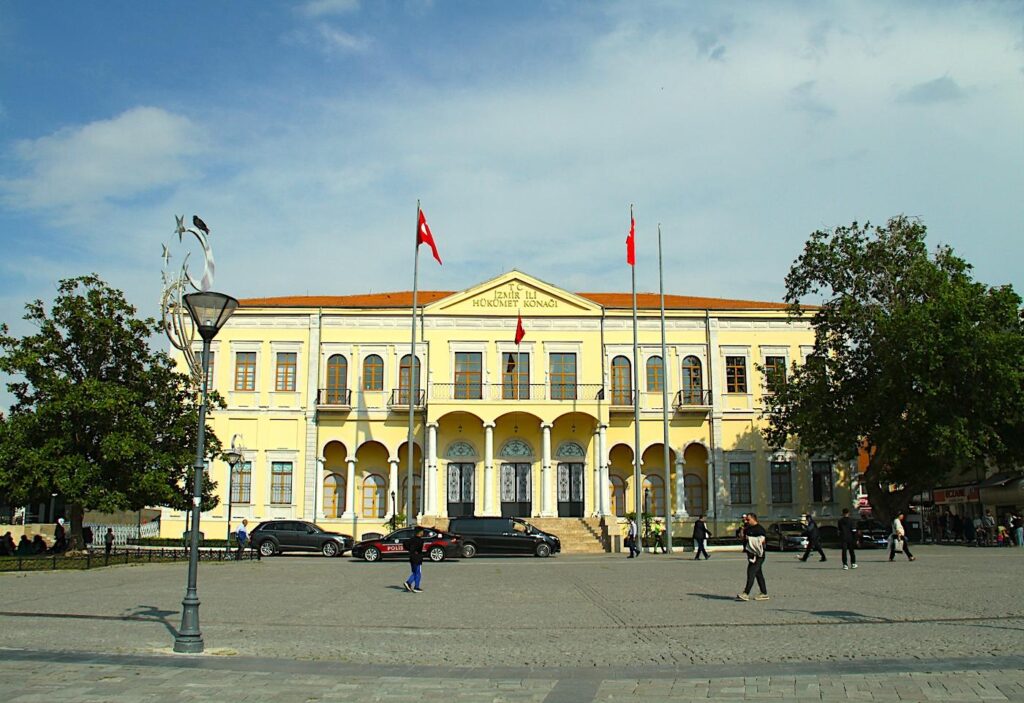
The building exhibits characteristics of Ottoman civil architecture, with influences from neoclassical and baroque styles typical of many official buildings from the late Ottoman period. The façade of the Government House is distinguished by its symmetry and features, such as arched windows and doors, decorative cornices, and a prominent central entrance. The entrance is accentuated by columns, giving it a grand and formal appearance. The building includes several rooms and halls designated for official ceremonies and meetings. These spaces are often more elaborately decorated, with features such as chandeliers, ornate woodwork, and detailed plasterwork. It continues to serve as the headquarters for the provincial governor and other key administrative offices and plays a crucial role in the governance and administration of the İzmir province.
Kemeraltı Market
Location: Kemeraltı Market – Konak, Anafartalar Cd., 35250 Konak/İzmir
Kemeraltı Bazaar is one of the city’s oldest and most vibrant marketplaces, with a rich history that dates to ancient times. The bazaar’s origins can be traced back to the Hellenistic and Roman periods when Smyrna was a significant trading hub. During the Ottoman period, Kemeraltı flourished as a bustling marketplace and expanded significantly in the 17th century when many of the covered sections (referred to as “khan” or “bedesten”) were built. These covered areas protected merchants and customers from the elements, fostering a thriving trade environment. The bazaar continued to grow and evolve through the 19th and early 20th centuries and was rebuilt after the Great Fire of Smyrna in 1922.
Kemeraltı Bazaar is known for its diverse shops and stalls, offering various goods and services. The bazaar is famous for its textile shops, selling everything from traditional Turkish fabrics and clothing to modern fashion items, handwoven carpets, kilims, and scarves. Numerous jewellery shops offer a variety of gold, silver, and precious stones. Traditional Ottoman-style jewellery and contemporary designs are available. Many stalls and shops sell various spices, herbs, and teas. You can find many handcrafted items, including ceramics, pottery, leather goods, and souvenirs. The bazaar features numerous food stalls and shops offering traditional Turkish delights, baklava, dried fruits, nuts, and other local delicacies. Kemeraltı has several shops selling old coins, manuscripts, furniture, and other collectables. Various shops offer everyday household items, kitchenware, and tools, catering to the practical needs of the local population.
The bazaar is characterized by a labyrinth of narrow streets and alleys, each filled with various shops and stalls. The main streets are often crowded with pedestrians, creating a lively and dynamic environment. Historic buildings and landmarks are scattered throughout the bazaar, including old mosques, hans (caravanserais), and fountains. Konak Square is located near the entrance of Kemeraltı; Kestanepazarı Mosque is one of the notable mosques within the bazaar. The Hanlar district within Kemeraltı features several historic caravanserais, such as the Kizlaragasi Han, where traders once stayed and conducted business.
Kızlarağası Hanı Market
Location: Tarihi Kızlarağası Hanı Han Yönetimi 871 Sokak No:19/106 Hisarönü, 35250 Konak/İzmir
The Kızlarağası Hanı Market is a historic and culturally significant marketplace constructed in 1744 during the reign of Sultan Mahmud I (1696-1754) by Hacı Beşir Ağa (died 1746), who was the chief eunuch (Kızlarağası) of the Ottoman palace. The market served as a commercial hub and caravanserai, providing lodging and storage for merchants travelling along the Silk Road and other trade routes. The market is a classic example of Ottoman architecture, featuring a rectangular plan with an inner courtyard surrounded by two stories of rooms. The ground floor typically hosted shops and storerooms, while the upper floor accommodated merchants. The structure’s design offered both goods and travellers a secure and comfortable environment. Throughout its history, Kızlarağası Hanı Market played a pivotal role in the commercial life of İzmir. As a bustling trade centre, it facilitated the exchange of goods such as textiles, spices, and crafts. The Han (inn) was part of a broader network of caravanserais across the Ottoman Empire, which were crucial in maintaining the flow of trade and communication. These inns were strategically placed to offer safe rest stops for caravans, contributing to the efficiency and security of overland trade routes.
With the advent of modern transportation and changes in trade patterns, the significance of caravanserais like Kızlarağası Hanı diminished. By the 20th century, many of these historic structures fell into disuse and disrepair. Today, the market has been revitalized and functions as a vibrant bazaar, housing shops selling traditional crafts, jewellery, antiques, and souvenirs, continuing its legacy as a centre of commerce.
Havra Sokağı Street
Location: Havra Sokağı – 35360 Konak/İzmir
Havra Sokağı, also known as Synagogue Street, is in the historic Kemeralti district. This street has deep historical roots, particularly tied to the Jewish community that has been an integral part of İzmir’s cultural fabric for centuries. “Havra” is derived from the Hebrew word “Havurah,” meaning a gathering or community. The Jewish presence in İzmir dates to ancient times, with a significant influx occurring after the expulsion of Jews from Spain in 1492. These Sephardic Jews settled in various parts of the Ottoman Empire, including Izmir, where they established a vibrant community. Havra Sokağı became the heart of this community, characterized by its numerous synagogues, Jewish schools, and cultural institutions. There is a dense concentration of synagogues, many of which date back to the 17th century, including Beth Israel, Shalom, and Etz Hayim. The architecture of these synagogues reflects a blend of Ottoman and Sephardic styles, with distinctive features like ornate Torah arks and intricate interior decorations.
The street is narrow and bustling, lined with traditional shops, markets, and stalls. It has been a focal point for trade and daily life, with Jewish merchants historically playing a prominent role in the commercial activities of the area. In the modern era, Havra Sokağı continues to be a vibrant commercial hub, famous for its fresh produce markets, spice shops, and traditional food stalls. Despite changes over time, the street has retained much of its historic charm and cultural significance. The street’s preservation and ongoing vibrancy underscore its importance as a cultural landmark and a symbol of the city’s rich multicultural identity.
Kültürpark
Location: Kültürpark İzmir – Mimar Sinan, 35220 Konak/İzmir
Kültürpark is one of the city’s most significant recreational and cultural landmarks. Its origins date back to the aftermath of a catastrophic event: the Great Fire of Smyrna in 1922, which devastated much of the city. The idea of creating a large public park and exhibition area was conceived as part of the efforts to rebuild and modernize Izmir. Kültürpark was officially opened in 1936, symbolising the city’s recovery and aspirations for the future. It was designed as a green space for leisure and a cultural and exhibition centre. The park covers an area of approximately 420,000 square metres and has since been a focal point for many of Izmir’s social and cultural activities.
Kültürpark is characterised by its blend of natural beauty and architectural elements. It features extensive lawns, flower beds, and a variety of trees and plants. It is also home to several ponds and a small artificial lake. Several notable structures are located here, such as the Izmir Art and Sculpture Museum, which houses a diverse collection of Turkish art. The park is also the site of the historical Parachute Tower, a popular attraction that offers panoramic views of the city.
One of the most significant events associated with Kültürpark is the Izmir International Fair, held annually since 1936. This fair is the oldest and most prominent trade show in Türkiye, attracting exhibitors and visitors worldwide. The fair showcases various products and services, from industrial goods to consumer products, and includes cultural performances, concerts, and other entertainment activities. It has helped position Izmir as the region’s major hub for commerce and culture. The park hosts festivals, concerts, exhibitions, and sporting events throughout the year, making it a vibrant centre of community life.
Konak Pier
Location: Konak Pier – Akdeniz, Pier AVM, Atatürk Cd. No:19, 35260 Konak/İzmir
Konak Pier was designed by the renowned French architect Gustave Eiffel, who is best known for the Eiffel Tower in Paris. The pier was constructed in 1890 during the Ottoman era, primarily serving as a customs house for the bustling port of İzmir. The distinctive architectural style of Gustave Eiffel is characterised by his use of iron and glass, a classical design with elegant arches and a spacious interior, reflecting the industrial aesthetic of the late 19th century. Its robust construction and aesthetic appeal have made it a notable example of Ottoman-period architecture influenced by European design. In its early years, Konak Pier played a vital role in the commercial activities of İzmir. As a customs house, it facilitated the processing of goods arriving at and departing from the port, contributing significantly to the city’s economy. The pier was a maritime trade hub, reflecting İzmir’s status as a key port city in the eastern Mediterranean.
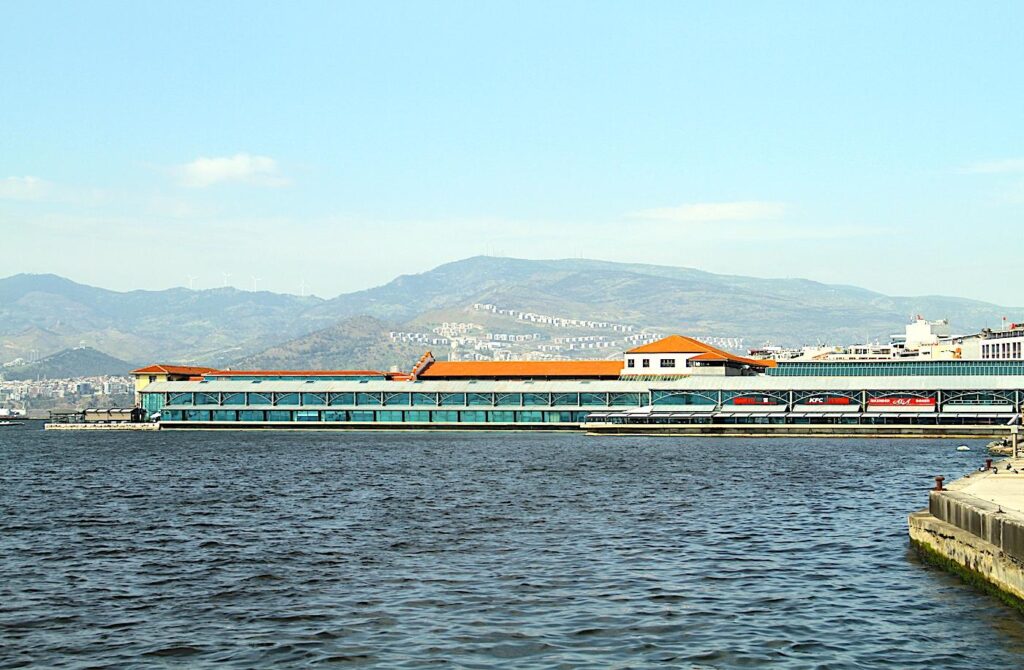
With the modernization of port facilities and changes in trade practices, the importance of Konak Pier as a customs house diminished over time. By the mid-20th century, the structure had fallen into disuse and disrepair. However, recognising its historical and architectural value, efforts were made to restore and repurpose Konak Pier. The project was completed in the early 2000s, transforming Konak Pier into a modern commercial and cultural complex. Today, Konak Pier serves as a vibrant centre for shopping, dining, and entertainment. It houses a variety of upscale boutiques, restaurants, cafes, and a cinema.
Kordon Waterfront
Location: 34860 Kartal/İstanbul
İzmir Kordon, also known simply as “Kordonboyu,” is a famous waterfront promenade that stretches along the Aegean Sea in İzmir. During the late Ottoman period, Kordon was developed as a fashionable district for the wealthy, featuring grand mansions, elegant buildings, and bustling commercial activities. It was a key part of the city’s social and economic life, frequented by locals and international visitors. The area thrived in the early 20th century, symbolising İzmir’s cosmopolitan character. However, the Great Fire of Smyrna in 1922 led to significant destruction in the area, and much of Kordon was rebuilt in the following decades. İzmir Kordon offers a variety of attractions that cater to both locals and tourists. Some key attractions include the Atatürk Museum, Republic Square (Cumhuriyet Meydanı), and Alsancak; many restored historic buildings and mansions now house cafes and restaurants; along the Kordon are pier and ferry terminals, and seaside parks.
İzmir Historical Elevator (Tarihi Asansör)
Location: İzmir Tarihi Asansör Binası – Turgut Reis, Şht. Nihatbey Cd. 76/A, 35000 Konak/İzmir
İzmir Asansör, also known as the Tarihi Asansör or Historical Elevator Tower, is a historic structure in the Karataş neighbourhood of İzmir. It was built in 1907 to provide a practical solution to the problem of navigating the steep cliffs that separate the upper and lower parts of this hilly area of the city. The Asansör was constructed by Nesim Levi (Bayraklıoğlu) to facilitate easier access between the narrow coastal area and the hilltop residential neighbourhoods; before its construction, residents and visitors had to climb a long, steep stairway of 155 steps. The elevator provided a much-needed transportation link, significantly improving the quality of life for residents. Over time, Asansör became more than just a practical transportation solution. It became an iconic landmark symbol of the city’s innovation and progress. In 1985, Asansör underwent significant restoration to preserve its historical and architectural integrity. The original steam-powered elevator was replaced with an electric one to enhance efficiency. Today, Asansör operates as a public elevator, providing practical transportation and a popular tourist attraction.
The Asansör Tower is a striking example of early 20th-century engineering and architecture combining functional and aesthetic elements. The structure consists of a tall brick tower that houses two elevator shafts. The tower is built into the cliffside, with its base at the lower street level and its top opening onto the higher street level. The tower’s base features neoclassical elements, with arched entrances and decorative mouldings. The brickwork is a key feature, giving the tower its distinctive and historic appearance. At the top of the tower is a spacious viewing terrace offering panoramic views of İzmir, the Aegean Sea, and the surrounding landscape. Adjacent to the viewing terrace is a restaurant and café where visitors can relax and enjoy refreshments while enjoying the views. The lower entrance to Asansör is located on Mithatpaşa Street, a busy thoroughfare in the Karataş neighbourhood. The upper entrance opens onto Halil Rifat Paşa Street, connecting to residential areas and providing easy access to the upper parts of the city.
İzmir Cable Car (İzmir Teleferik)
İzulaş A.Ş. İzmir Balçova Teleferik – Teleferik, Sakarya Cd. No:131/A, 35330 Balçova/İzmir. Open Tuesday-Sunday 11:00-18:00. Ride fee approximately €1 (TL40 in July 2024). İzmir Teleferik Turkish Website.
İzmir Cable Car (İzmir Teleferik) is a popular tourist attraction located in the Balçova district of İzmir. It offers stunning panoramic views of İzmir Bay, the city skyline, and the lush green landscapes of Dede Mountain. It connects the lower station near the Balçova Thermal Hotel to the upper station on Dede Mountain, rising 418 metres. Initiated in 1974, the modern cable car system was refurbished and reopened in 2015 with 20 colourful cabins for 8 people. The ride covers approximately 810 meters, can carry a capacity of 1,200 passengers per hour and takes around 7-8 minutes one way. The upper station has cafes, restaurants, and walking paths for hiking and nature walks, offering well-marked trails. There are playgrounds and recreational areas for families and children. The cable car system is designed to be accessible to all visitors, including those with disabilities, including wheelchairs and baby strollers.
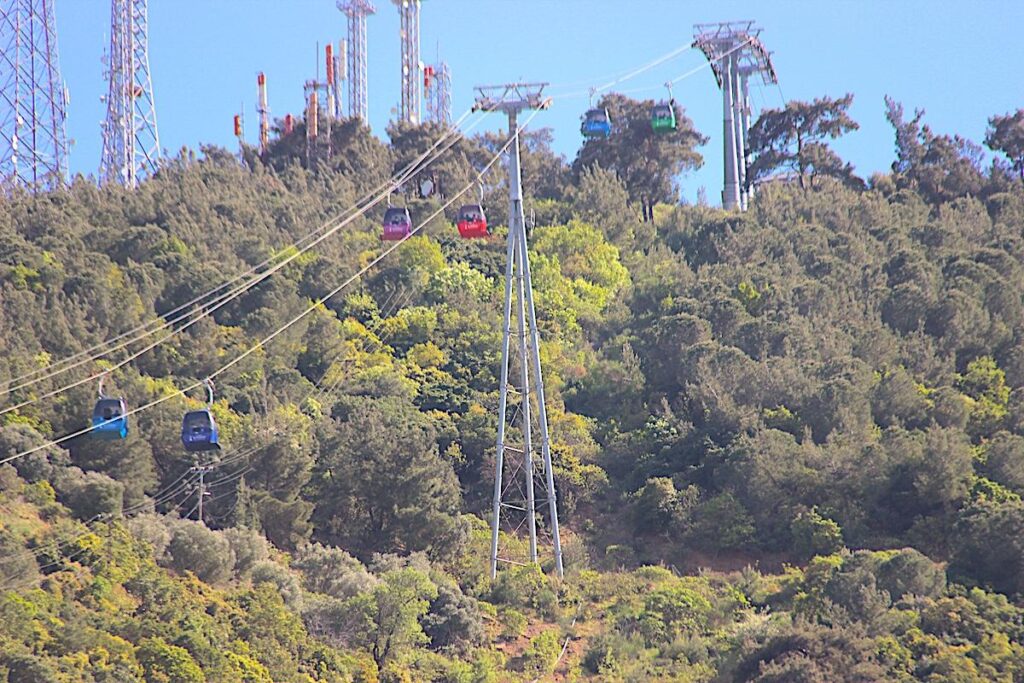
Agamemnon Hot Springs (Thermal Springs at Balçova)
Location: Termal Otel – Korutürk, 35330 Balçova/İzmir.
Known today as the Balçova Thermal Hotel, the ancient springs were narrated in the epic stories of the Greek poet Homer (circa 12th-8th Century B.C.) and the works of the Greek geographer and historian Strabon (1st Century A.D.). The Agamemnon Thermal Springs is named after the King of Mycenae, who attacked the city of Troy in Greek mythology and has been used for healing since ancient times. While there is no historical evidence of the event, it is thought that these thermal springs were used to treat the wounds of the soldiers of Alexander the Great and were the most famous during those ages.
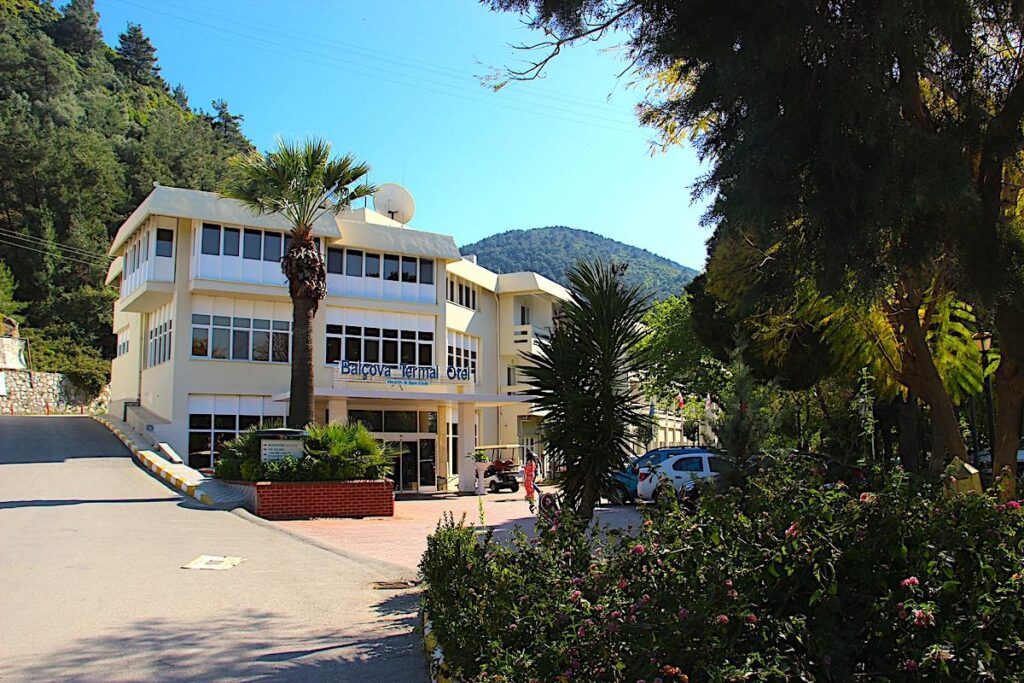
Agamemnon Hot Springs was rediscovered by a Frenchman named Elfont Mil in 1763. It was rebuilt and later developed with accommodation and various treatment facilities. Popular with domestic and international visitors, especially from Norway, the hot springs’ water temperature is 63ºC; the radioactivity ratio is 3.3, and the healing water contains sodium bicarbonate and chloride. The Agamemnon Hot Springs is particularly beneficial in treating chronic upper respiratory tract inflammation, nephritis, other inflammations, rheumatic syndromes, metabolic disorders, and skin diseases.
See also LikeCesme.com: Thermal Springs
Ege University Botanical Garden-Herbarium
Location: EÜ Botanik Bahçesi ve Herbaryum Araştırma ve Uygulama Merkezi – Erzene, 35040 Bornova/İzmir. Open Monday – Friday 08:00-17:00. Ege University Botanical Garden-Herbarium English Website.
Ege University Botanical Garden and Herbarium is a botanical research and conservation institution located within Ege University in Bornova, İzmir. Established in 1962, the garden spans around 48 hectares and serves as a vital resource for education, research, and conservation of plant biodiversity. The garden boasts a diverse collection of plants, including both native and exotic species. It is home to various thematic sections such as medicinal plants, endemic plants, succulents, and ornamental plants. The garden plays a crucial role in conserving rare and endangered plant species and supports research in botany, horticulture, and environmental science, providing resources and facilities for scientists and students.
The herbarium at Ege University Botanical Garden houses an extensive collection of preserved plant specimens vital for taxonomic studies and reference material for researchers. It serves as a repository of plant diversity. The garden includes greenhouses that support the cultivation of plants requiring specific climatic conditions. Beyond its scientific and educational functions, the botanical garden serves as a recreational area for visitors, providing a serene setting for relaxation, nature walks, and the enjoyment of the beauty of the environment and diverse plant species.
See also LikeCesme.com: Uzbaş Arberatorium
İzmir Wildlife Park
Location: İzmir Büyükşehir Belediyesi İzmir Doğal Yaşam Parkı – Sasalı, Ahmet Piriştina Cd. No:3, 35620 Çiğli/İzmir. Open Tuesday – Sunday 09:00-18:30. Entrance Fee TL30 (approx €1 July 2024).
İzmir Wildlife Park, located in Çiğli, İzmir, is a vast and modern zoological park that provides a natural and spacious environment for its diverse animal inhabitants. The park spans approximately 425 acres and includes large enclosures, water features, and extensive greenery. It is home to over 1,500 animals representing more than 120 species of mammals, birds, reptiles, and aquatic animals. Some notable species include lions, tigers, elephants, giraffes, zebras, and various bird species. İzmir Wildlife Park strongly emphasises conservation and the protection of endangered species, participates in breeding programs, and collaborates with other institutions globally to support wildlife conservation efforts. The park includes various visitor amenities such as cafes, picnic areas, playgrounds, souvenir shops, and rest areas.
See also LikeCesme.com: Çiğli (İzmir) Bird Paradise
